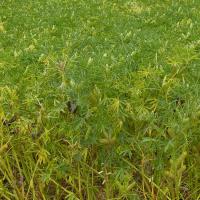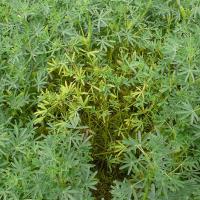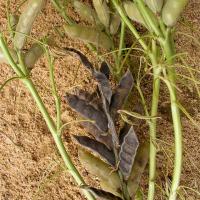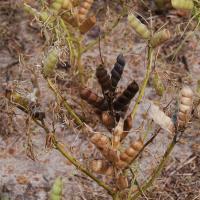Diagnosing black pod syndrome in narrow-leafed lupins
Black pod syndrome (BPS) is a symptom caused by bean yellow mosaic virus (BYMV) infection of lupin plants after pod set. BYMV is an aphid-borne virus found predominantly in high rainfall wheatbelt zones.
What to look for
- Podding plants with yellow leaves, while pods turn black and become flattened and shrivelled.
- Plants can be affected first and most severely on paddock edges or other bare areas, particularly on the windward side and adjacent to legume pastures.
- Patches are also common with infection spreading out from the centre.
Paddock
- Leaves turn yellow and drop.
- Plants after pod set have black pods and necrotic streaks on the stem.
- Seeds fail to develop.
- Varieties vary in symptom development.
Plant
What else could it be
| Condition | Similarities | Differences |
|---|---|---|
| Diagnosing spring drought in narrow-leafed lupins | Leaf yellowing | Withered pods are light brown rather than black |
Where did it come from?

Alternate host
- BYMV strains that are endemic in south-western Australia are not seed-borne in lupins, unlike overseas strains.
- The main source of BYMV is infected clover plants in adjacent pastures. The virus is seed-borne in clover and survives from one growing season to the next in the pasture seed bank. Clover weeds in lupin crops are an additional source if not controlled. Perennial native legumes in adjacent bush may occasionally act as BYMV reservoirs.
- If there are no internal clover weed sources, BYMV infection is highest near the edge of a lupin crop close to pasture, especially at its windward edge.
- Aphids spread BYMV from infected clover plants to lupin crops when aphid populations build up in late winter/early spring.
Management strategies

Grass pasture control
- An integrated disease management approach is needed to control BYMV in lupin crops:
- Sow a non-host crop (for example, cereal) border strip between crops and adjacent pasture. Incoming aphids lose the virus when they probe the non-host which helps to decrease spread into the crop from an external source.
- Avoid paddocks with large perimeter to area ratios. This reduces exposure of the crop margin to adjacent BYMV-infected pasture.
- Control clover weeds effectively to minimise virus infection sources within the crop.
- Note: Insecticides applied to crops are ineffective at controlling BYMV.
How can it be monitored?
- Test a representative seed sample to determine the level of infection.
See also
Where to go for expert help
Page last updated: Thursday, 16 April 2015 - 4:27pm





